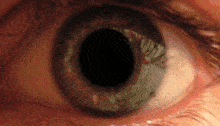A simple word is enough to trigger a reaction in your pupil.

A surprising new study found that when we hear words associated with a strong luminosity (ie “sun” or “shine”) our pupils contract as if we were actually exposed to them. The same thing happens to words we associate with darkness — our pupils dilate. The responses can have a variety of causes, from an involuntary reflex reaction to feelings of arousal to exposure to light. The latter is most common and often most pronounced.
This mechanism is done through the optic and oculomotor cranial nerve. Many creatures, humans included, exhibit a pupillary response. This is basically a mechanism through which the brain tries to adapt the body to new conditions, but it’s not totally clear why the reaction is also associated with psychological responses. What this study did is to open new avenues of research, and show that the dilation and contraction mechanism might be more complex than we thought.
“Theories about embodiment of language hold that when you process a word’s meaning, you automatically simulate associated sensory input (e.g., perception of brightness when you process lamp) and prepare associated actions (e.g., finger movements when you process typing),” the study reads. “To test this latter prediction, we measured pupillary responses to single words that conveyed a sense of brightness (e.g., day) or darkness (e.g., night) or were neutral (e.g., house).”

Not all responses were alike. The brighter (or darker) the word people heard, the stronger the response, which in itself seems to raise more questions than it answers.
It seems to fit with a theory called the ’embodiment of language’. Basically, the theory says that whenever we hear a word or a group of words, we mentally simulate it in our mind. If someone would say ‘keyboard,’ your brain would project an image of the keyboard, as well as the gesture of typing at a keyboard; even if you might not realize it. The same thing happens with ‘sun’ — you visualize a big ball of fire, and your pupil adapts. However, researchers say, behavioral studies have so far not directly tested one of the central predictions of embodied language: that word meaning by itself can trigger, at least in some cases, associated involuntary actions. This is why this particular study is so important: it can be a definite proof for a long-standing but still challenged theory.
Journal Reference: Sebastiaan Mathôt, Jonathan Grainger, Kristof Strijkers. Pupillary Responses to Words That Convey a Sense of Brightness or Darkness. Psychological Science, 2017; 095679761770269 DOI: 10.1177/0956797617702699






